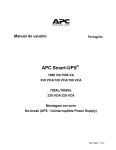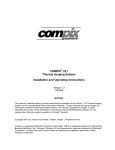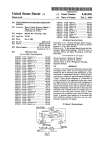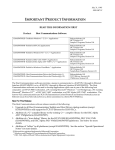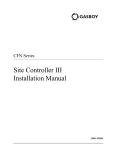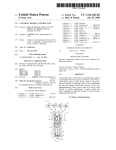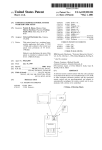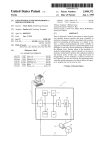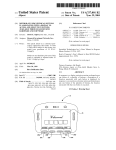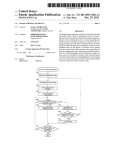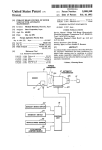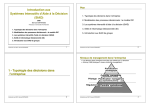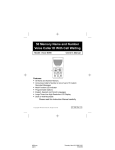Download Controls for a vehicle audio/video apparatus
Transcript
US00527 1063A United States Patent [19] [11] Patent Number: 5,271,063 d’Alayer de Costemore d’Arc [45] Date of Patent: Dec. 14, 1993 [54] I FOREIGN PATENT DOCUMENTS ' [75] Inventor: 373387 Stephane M. d’Alayer de Costemore d Arc’ Brussels’ Belgmm [73] Assignee: Staar S.A., Brussels, Belgium [2;] 03- 4, 1991 Primary Examiner-Jin F. Ng Assistant Examiner-Nina Tong the nature of a selected function of an audio/video Céis ..................................... reproduction apparatus by varying an adjustment of the I l ' ' ' """"""""""" 11/10:?’ 811/ 067’ 58 F. m f s h /382’ 86 / ’ 082/1103 I 1 ‘e 0 we """""""" " 1/‘ 3g 1 1641 8’ 107’ 1/ [56] European Pat. Off. . Attorney, Agent, or Firm-Leydig, Voit 8t Mayer [57] ABSTRACT A apparatus and method for permitting perception of [21] Appl. No.: 771,098 [22] Filedi 6/1990 2138453 9/1937 United Kingdom . ’ 9 ' References Cited function selected. The selected function (such as speaker‘ balance, bass, treble, or fade) is identi?ed to the user by automatically varying the adjustment of the selected function between two predetermined settings. This allows the user to adjust the audio/video apparatus without distracting his attention from the road in a moving which U.S. PATENT DOCUMENTS 4,746,919 5/1988 4,903,307 2/1990 Ozawa et a1. ..................... .. 381/ 103 Reitmeier . 18 Claims, 2 Drawing Sheets FUNCTION ADJUSTING CONTROL 5 W’ I k 4 I FUNCTION SELECTING CONTROL 6 > I > CONTROL a“. i - ' " CIRCUITIO \ ( ‘ Mir» ADJUSTMENT CIRCUIT I2 , \ MEMORY I l - l4 LOUDSPEAKER I6 US. Patent Dec. 14, 1993 5 Q6 Sheet 1 of 2 ‘5,271,063 ,2 3 ‘ ii] Q 0 O O O O O O, Y 41 F I G. l FUNCTION ADJUSTING iCONTROL 5 LO-OOOOO-OO-b J 4 l \ > CONTROL FUNCTION SELECTING CONTROL 6 - t ( ’ ADJUSTMENT AMP CIRCUITIO CIRCUIT l2 \ y MEMORY n FIG. 2 l4 LOUDSPEAKER l6 1 5,271,063 2 vice requires that the user previously record the com; CONTROLS FOR A VEHICLE AUDIO/VIDEO APPARATUS The present invention relates to mechanisms for con trolling audio/video reproduction apparatuses and, more particularly, for setting levels for such functions as sound volume, bass level, treble level, and balancing the relative sound volume levels between loudspeakers of apparatuses such as radios, and audio and video cas sette players which are installed in motor vehicles. Many knobs and functions on the front of an audio/v ideo reproduction apparatus relate to controlling char acteristics of the audio output signals. A typical appara tus outputs several independent audio signals on respec mands in such a manner that the apparatus is able to recognize voice instructions and carry out the appropri ate adjustments. The device substantially increases the price of the apparatus which is undesirable. Addition ally, this recorded voice arrangement is very compli cated for the average user and can only be controlled by a single user. SUMMARY THE INVENTION The main object of the present invention is to allevi ate the above-mentioned disadvantages by providing a simple, economical, and easy to operate control mecha nism which permits‘ the user to select and actuate the desired control without having to divert his attention from the road. A further object of this invention is to tive audio channels. The output audio signals power a plurality of loudspeakers which are respectively con provide the added functionality without signi?cantly nected to the audio channels. A typical con?guration is increasing the cost of the apparatus. a motor vehicle which contains a left front, right front, The present invention achieves these objects and left rear, and right rear loud speaker. Balance refers to 20 overcomes the aforesaid problems by providing a sim an ability to adjust the relative sound volume between ple, reliable control apparatus that provides an identi? the loudspeakers on the left and right sides of the vehi cation program in which the different functions are cle. A balance function enables a user to establish an identi?ed by automatically varying each function be equilibrium between the left and right loudspeakers tween pre~established levels in a user perceptible man ner that can be recognized by a user, and which then provides for the user to adjust each function to a desired based on the user’s preference. Fade function refers to an ability to control the relative volume between loud speakers located in the front and rear of the vehicle. A fade control function allows the user to establish an equilibrium between the front and rear speakers based on the user’s preference. The term stereophonic refers to an ability of the audio/video apparatus to reproduce different sounds on loudspeakers connected to different audio channels. Sound equalization refers to an ability of the audio/video apparatus to alter the audio output of one or more audio channels by changing the relative 35 amplitude of all frequencies (balance function) or of some frequency components, such as low frequencies (base function), or high frequencies (treble function). level determined by the user. According to the inven tion, once the control apparatus enters the identi?cation program, each of the sound equalization characteristics of an audio output are automatically varied between two different audibly perceptible levels. This enables the user to recognize each function. The identi?cation program then permits the user to adjust each function to suit the user’s preferences. An apparatus constructed according to the present invention includes: selecting means for selecting a func tion of an audio/video apparatus; function determining means for automatically actuating the function selected and for identifying the function selected by varying the A typical audio/video apparatus contains a profusion of control knobs, having a single knob for each func 40 function between two different levels to enable recogni tion. This arrangement is unsatisfactory in a motor vehi tion of the function actually selected; and adjusting cle since a driver must momentarily divert attention means for adjusting the function selected. from the road to determine which knob, from the large The operation of one embodiment of the invention number of knobs, is the knob one wishes to adjust. can be illustrated using the balance function. A ?rst Alternatively, some apparatuses contain a single 45 actuation of a function selecting control causes the ap function selecting control used to select a function to be paratus to enter the balance adjustment mode. In order adjusted and a single adjustment control used to adjust to enable the user to recognize that this function is the function selected. As the function selecting control is manipulated, a display panel displays the function activated without distracting attention from the road, the stereophonic balance is cycled by alternatively currently selected. The adjustment control is then ma varying the relative volume between the left and right audio channel. For example, audio reproduction is en abled on only the left channel, then after the lapse of the short time interval, only on the right channel, and re peatedly cycled between left and right channels for a predetermined time period. Once the user recognizes that the function selecting control is set to the balance nipulated to adjust the function. This arrangement is also unsatisfactory because, in order to determine which function is selected, the driver’s attention is mo mentarily distracted to read the function displayed on the front panel of the apparatus. Additionally, the dis play is often dif?cult for the driver to read. In some situations, there are numerous drivers for a single vehicle (e.g. company cars, rented vehicles etc.). function, the user is free to actuate the function adjust ment control to adjust the stereophonic balance. A new The new driver rarely consults the instruction manual actuation of the function selecting control, advances the of the audio/video apparatus before driving. Conse— apparatus to a new function (i.e. fade), and the process quently, the new driver determines how the apparatus is repeated by varying the relative volume of the front operates at the same time he is driving. This can be and rear speakers. Other functions may be identi?ed in dangerous since the drivers attention will be distracted a similar manner. from the road. Thus, the above mentioned audio/video A method is also provided which permits the user to function selection techniques are unsatisfactory. 65 perceive the nature of a selected function of an appara One device is known which addresses such audio/v tus for audio/video reproduction. The method includes ideo function selection problems by recognizing adjust the steps of: selecting a function of an audio/video ap ment commands rendered by voice. However, the de paratus; automatically actuating the function selected 3 5,271,063 by varying the function between two different levels, enabling the user to recognize the function actually selected; and allowing the user to adjust the function selected. Additional advantages and characteristics of the in vention appear in the description of a preferred embodi ment described hereinafter. tion, in keeping with the invention, the control unit 10 actuates and executes an identi?cation program of pre recorded instructions which is stored in the memory 11. BRIEF DESCRIPTION OF THE DRAWINGS FIG. 1 is a front view of a car radio-cassette appara This identi?cation program modi?es the functions of tus incorporating an embodiment of the invention; P16. 2 is a block diagram of the circuit incorporated in the apparatus shown in FIG. 1; and FIG. 3 is a flow diagram of a program of prerecorded instructions enabling the implementation of the appara 15 tus shown in FIG. 1. DESCRIPTION OF THE PREFERRED 4 state which recalls initial parameters stored in memory 11. The parameters are used to initialize settings of the audio function. In a preferred embodiment, the default setting for the function adjustment control 5 is to con trol the sound volume of the apparatus. After initializa the function selecting control 6. FIG. 3 is a flow diagram of the prerecorded instruc tions contained in memory 11 and executed in the con trol unit 10. Referring to FIG. 3, as indicated in the ?rst block 30, whenever the function selecting control 6 is not actuated, the function of the function adjustment control 5 is to control the sound volume which can be increased or decreased at will by the user. This function is chosen because of its frequency of use, but any other EMBODIMENTS priority function can be chosen arbitrarily. A ?rst actua Referring to FIG. 1, a car radio-cassette player incor 20 tion of the function selecting control 6 causes the pro porates a display panel 2, a tape insertion slot 3 (permit gram to enter the balance adjustment mode 31. In order ting the insertion or ejection of a cassette), a plurality of to enable the user to recognize that this function is radio frequency selection controls 4 (permitting the activated without distracting attention from the road, storage and selection of preferred radio broadcasting the balance is cycled by alternatively varying the rela stations), and a function adjustment control 5 associated 25 tive volume between a left and a right loudspeaker. with a function selecting control 6. Referring to FIG. 2, which is a block diagram of the electronic circuitry incorporated in the apparatus of Both of the rear loudspeakers are desirably turned off for this adjustment. The program in the memory 11 instructs the control unit 10 to automatically enable the adjustment circuit 12 to vary the balance between the FIG. 1, a control unit 10 is associated with a memory 11. The control unit 10 includes a microprocessor exe 30 left and the right loudspeaker. For example, balance is cuting a program of prerecorded instructions stored in varied by enabling reproduction on only the left chan the memory 11. The memory 11 may be located on nel 32, then after the lapse of a short time interval 33 either inside or outside of the microprocessor. An ad (e.g. t=approximately 300 milliseconds) enabling only justment circuit 12, inputs one or more audio signals, the right channel 34, and then enabling the channels modi?es the audio signals in accordance with sound 35 alternately and/or successively for a predetermined equalization instructions received from the control unit time period 35 (approximately 2-3 seconds). _ 10 (i.e. volume, fade, treble, bass, etc.), and outputs the equalized audio signals to the ampli?cation circuit 14. The ampli?cation circuit 14 ampli?es the audio signals and transmits them to one or more loudspeakers 16. The adjustment circuit 12 may be of the “SOFAC” type used in some audio/video systems (see, for exam ple, Phillips car radio-cassette n° 22DC774). The ampli ?cation circuit 14 may be used as either an ampli?er or The predetermined time period may be interrupted at any time by the user again actuating the function select ing control 6, or the function adjustment control 5. 40 Once the user recognizes that the function selecting control 6 is set to the balance function, the user is free to actuate the function adjustment control 5 and thereby adjust the balance. Within a predetermined time period 36 (approxi a preampli?er. The knobs controlling the functions and 45 mately 3-4 seconds), the user may adjust the balance adjustments of the apparatus may be linked to the con between the left and right speaker by manipulating the trol unit 10 or to the adjustment circuit 12, depending function adjustment control 5. If a new value is input by on whether an intercommunication bus exists between these two circuits. the user, the balance function is set to this value and stored for future use 37. If no modi?cation was made by In commercially available units, the function select 50 the user, the apparatus retains the old balance level, and ing control 6 is used to select a particular function of the apparatus such as base, treble, balance and fade adjust ment. The function currently selected is displayed on the display panel 2. A new function can be selected by advances to select the fade function 40 automatically. Alternatively, the function selection is advanced by the user again actuating the function selecting control 6. In carrying out the invention, the different functions again actuating the function selecting control 6. In this 55 to be identi?ed are successively selected by following manner, all functions of the apparatus can be cycled by the identi?cation program shown in FIG. 3. Thus, the using a single function selecting control 6. A function apparatus advances to the fade function 40 and operates adjustment control 5 is provided to adjust the function in a similar manner as for the balance function previ selected. However, in commercially available units the ously described. The control unit 10 activates the ad user must read the display panel 2 each time that the justment circuit 12 to stimulate variations in the balance function selecting control 5 is pressed to determine between front 42 and rear 44 loudspeakers, while mo which function is currently selected. Such apparatus mentarily increasing the output volume slightly to help incorporates a “PC Bus” interconnecting the control the user recognize the fade function. The fade is alterna unit 10 and the adjustment circuit 12. Additionally, the tively adjusted between the front and the rear loud function controls 4, 5 and 6 are connected to the inputs 65 speaker corresponding to a predetermined interval 43 so of the control unit 10. that the user immediately recognizes the function se According to the present invention, upon powering lected. Within a predetermined time period 46, the user up, the control unit 10 is activated and enters an initial can modify the fade between the front and rear loud 5 , 5,271,063 speaker by manipulating the function adjustment con 6 the functions which he desires. Pressing the function trol 5. If a new value is input by the user, the fade func tion is set to this value and it is stored for future use 47. If no value is entered after a predetermined period, the fade function is returned to the old value, and the treble selecting control 6 interrupts the predetermined time period and immediately advances the program to the next function. The device cycles through all of the adjustments without the user having to press the func tion selecting control 6 to advance to the next adjust ment parameter. If desired, this automatic advance fea level adjustment function is selected. Alternatively, a new actuation of the function selecting control 6 before the predetermined period, will result in the treble level ture may be eliminated so that the user manually ad adjustment function being selected. vances the function selected by manipulating the func The apparatus then automatically advances pursuant tion selecting control. to the identi?cation program according to the invention to the treble level adjustment function 50 and operates In a further embodiment, the functions can be varied between two different pre-established levels, or a plu in a similar manner as for the balance and fade functions rality of levels, rather than varying the functions be previously described. To enable user recognition of the treble level adjustment function, the control unit 10 acts on the circuit 12 to switch the treble level to its maxi mum value 54 while switching the bass level to its mini mum value. The variation in the treble occur for a pre determined interval. This enables the user to recognize that the function selecting control 6 is positioned on the tween their maximum and minimum level. In the case of small dimension loudspeakers such as those mounted in vehicles, an adjustment of the bass level to the maxi mum and/or the treble to the minimum may result in saturation of the audio output and generate an unpleas ant noise. This can be avoided by varying the parameter 20 between a level which is less than the minimum and treble level adjustment function. Having recognized this function, the user has the option to act on the func maximum levels possible. An alternative to using time intervals is to measure tion adjustment control 5 in order to modify the treble level within the predetermined time period 56. It is the cyclic variations by the number of cycles per formed. Additionally, the method used to input the preferable to increase the volume slightly during the 25 function selecting control 6 and the function adjustment predetermined interval, and while the treble is being control 5 is not critical, and may be made by manual, adjusted. If a new value is input by the user, the treble is set to the value and it is stored for future use 57. If no value is input, the previous treble level is restored and the program advances to the bass level adjustment func tion. Upon expiration of a predetermined time period or a new actuation of the function selecting control 6, the program 60 advances to selecting the bass level adjust ment function. As for the bass level adjustment, the control unit 10 35 actuates the adjustment circuit 12 in order to make the bass level pass to a maximum level 64, for a predeter mined time period while setting the treble level at its minimum value. Having recognized this function, the user has the option to act on the function adjustment control 5 in order to modify the bass level adjustment. If a new value is input by the user, the bass is set to the value and it is stored for future use 67. At the expiration 66 of the predetermined time period or upon actuation of the function selecting control, the program returns to 45 its starting point. In this state, function adjustment con trol 5 is used exclusively for adjusting of the sound volume of the apparatus. The apparatus according to the invention has the advantage that the user does not need to locate a partic ular knob from a multitude of knobs, or turn his visual audio, or remote input mechanisms. Both the function selecting control and the function adjustment control may be provided by a single means. I claim: 1. An apparatus which assists a user to recognize selected audio/video reproduction functions compris ing: function selection means for selecting different func tions which adjust an audible characteristic of an audio/video apparatus; identifying means including an identi?cation program for identifying each of the different functions to a user by automatically successively selecting the different functions for predetermined time periods and repetitively producing variations in each func tion during its respective time period between pre established audibly-perceptible levels, thereby en abling the user to recognize each function by hear ing the variations in the function; and - adjusting means operable by the user for adjusting the function recognized by the user to a user desired level, sad adjusting means being operable at any time during each respective time period or during an interval established by the identi?cation pro gram after each of the time periods. attention to a screen and thus distract his attention from 2. An apparatus according to claim 1, wherein actua driving. An additional advantage is that the user need tion of said selecting means automatically initiates the not read the user’s manual before operating the appara identi?cation program for identifying each of the func tus. Additionally, the apparatus does not require any 55 tions selected. special or additional circuitry since it is based exclu 3. An apparatus according to claim 1, wherein a new sively upon existing circuits. The device only requires a function is automatically selected after a predetermined portion of the memory 11 of the control circuit 10. The time period. I capacity of the memory can be easily increased if 4. An apparatus permitting perception of the nature needed. Consequently, this device has the advantage of 60 of sound equalization functions comprising: not signi?cantly increasing the existing cost of the appa audio/video reproduction means having a plurality of ratus. The above embodiment includes provisions for the automatic selection of the various functions and adjust ments so that a single actuation of the function selecting 65 control 6 automatically ensures the sequential selecting of the various functions without further user interven tion. The user is only required to make adjustments in sound equalization functions; adjusting control means for inputting user commands; adjusting means, responsive to said adjusting control means, for adjusting the plurality of sound equal ization functions; at least one control means for selecting one of the plurality of sound equalization functions; and 7 5,271,063 identi?cation means, responsive to actuation of said at least one control means, for automatically repeti 8 sound representing a bass function to the user by de-em phasizing high frequency components. tively varying the sound equalization function se lected between two different levels, thereby en abling a user to recognize the selected sound equal 15. An apparatus according to claim 10 wherein the audio/video player includes a plurality of different ad justment circuits for adjusting audible characteristics of ization function by hearing the different levels. the respective functions; 5. An apparatus according to claim 4, wherein the identi?cation means comprises a microprocessor con taining a memory, wherein the microprocessor executes IO prerecorded instructions stored in the memory. 6. A method for assisting a user to recognize a se duction comprising the steps of: ferent functions for predetermined time periods selecting a function of an audio/video apparatus; and produce variations in audible sound represent automatically identifying the function selected by ing each function during its respective time period, repetitively varying the function between two pre and determined levels of sound which are audibly per ceptible thereby enabling a user to recognize the function actually selected; and ' 20 a user desired level. reproduction functions of an audio/video player com prising: predetermined period. 8. Method according to claim 6, wherein the varia 25 tion of the function is performed cyclically over a pre determined period. function selecting control means for selecting differ ent functions which adjust audible characteristics of the audio/video player; identifying means including an identi?cation program for identifying the different functions to a user by 9. Method according to claim 6, wherein the adjust ing of the function selected must be performed within a automatically successively selecting the different pre-established time period, after which the selecting functions for predetermined time periods and pro ducing variations in audible sound representing each function during its respective time period, thereby enabling the user to recognize each func means restores an initially selected function. 10. An apparatus which assists a user to recognize reproduction functions of an audio/video player com function selecting control means for selecting differ ent functions which adjust audible characteristics of the audio/video player; to provide an interval following each time period during which the user may adjust the adjustment circuit corresponding to the recognized function to 16. An apparatus which assists a user to recognize selecting a function occurs ?rst, and enables automatic selection of additional functions after a delay having a prising: the identifying means is operable in response to a start signal and modi?es the function selecting control means to automatically successively select the dif lected function of an apparatus for audio/video repro adjusting the function selected. 7. Method according to claim 6, wherein the step of the function selecting control means is manually op erable and operatively connected to select among each of the different adjustment circuits; and 35 identifying means including an identi?cation program for identifying the different functions to a user by tion, the identifying means including means oper ated responsive to the identi?cation program for producing audible sound representing a treble function to the user by emphasizing high frequency components and de-emphasizing low frequency components; and function adjusting control means for adjusting the automatically successively selecting the different functions for predetermined time periods and pro function recognized by the user to a user desired ducing variations in audible sound representing level. time periods and producing variations in audible 17. An apparatus which assists a user to recognize sound representing each function during its respec 45 reproduction functions of an audio/video player com prising: tive time period, thereby enabling the user to rec ognize each function; and function selecting control means for selecting differ ent functions which adjust audible characteristics of the audio/video player; function adjusting control means for adjusting the function recognized by the user to a user desired level. 50 11. An apparatus according to claim 10, wherein the identifying means includes a means operated responsive to the identi?cation program for producing audible sound representing a treble function to the user by em phasizing high frequency components. 55 12. An apparatus according to claim 10, wherein the identifying means includes a means operated responsive to the identi?cation program for producing audible sound representing a treble function to the user by de 13. An apparatus according to claim 10, wherein the identifying means includes a means operated responsive to the identi?cation program for producing audible sound representing a bass function to the user by em 14. An apparatus according to claim 10, wherein the automatically successively selecting the different functions for predetermined time periods and pro ducing variations in audible sound representing each function during its respective time period, thereby enabling the user to recognize each func tion, the identifying means including means oper ated responsive to the identi?cation program for producing audible sound representing a bass func tion to the user by emphasizing low frequency emphasizing low frequency components. phasizing low frequency components. identifying means including an identi?cation program for identifying the different functions to a user by components and de-emphasizing high frequency components; and function adjusting control means for adjusting the function recognized by the user to a user desired 65 level. 18. An apparatus which assists a user to recognize identifying means includes a means operated responsive reproduction functions of an audio/video player com to the identi?cation program for producing audible prising: 5,271,063 10 a plurality of different function adjusting circuits for operable in response to a series of program instruc adjusting audible characteristics of the reproduc tion functions; manually operable function selecting control means for selecting among the different function adjusting circuits manually; function adjusting control means operable manually tions for successively selecting the different func tion adjusting circuits for predetermined time peri » ods and for adjusting the respective circuits to produce variations in audible sound representing each function during its respective time period, by the user for adjusting to a user desired level thereby enabling the user to recognize each func tion, and for providing an interval following each each of the functions corresponding to the function of the predetermined time periods during which adjusting circuits selected by the function selecting the function recognized by the user may be ad justed to a desired level by manually operating the control means; and identifying means operable automatically in response function adjusting control means to adjust the re to a program start signal for identifying the differ spective circuit. ent functions audibly to a user including means ‘ 15 25 35 45 55 65 i i i t UNITED STATES PATENT AND TRADEMARK OFFICE CERTIFICATE OF CORRECTION PATENTNO. : 5,271 , 063 DATED : December 1 4 , INVENTOR(S): 1 993 Stephane M. d'Alayer de Costemore d'Arc It is certified that error appears in the above-indenti?ed patent and that said Letters Patent is hereby corrected as shown below: On the title page of the patent, beneath item [22], insert: --[30] Nov. Foreign Application Priority Data 19, 1990 [BE] Belgium . . . . . . . . . . . ..9O 01088--. Column 6, line 48, change "sad" to -'--said—-. Signed and Sealed this Sixteenth Day of August, 1994 BRUCE LEHIVIAN AfteSting Oj?cer ‘ Commissioner of Patents and Trademarks












